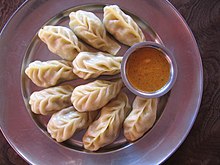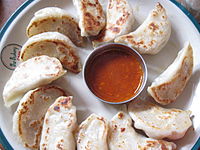food.wikisort.org - Dish
Momo are bite-size dumplings made with a spoonful of stuffing wrapped in dough. Momo are usually steamed, though they are sometimes fried or steam-fried. Meat or vegetables fillings becomes succulent as it produces an intensively flavored broth sealed inside the wrappers. Momo is an important dish for Tibetans and Nepalese , both for everyday and festivals. Variants of the dish developed later in Nepal after which it became popular among Asians.[1]
 A typical serving of a plate of momo with sesame yellow sauce and red ginger chilli pickle. | |
| Place of origin | Tibet, |
|---|---|
| Region or state | Tibet, Sikkim, Kalimpong (India), Nepal |
| Associated national cuisine | Tibetan cuisine, |
| Main ingredients | White-flour-and-water dough; meat, vegetable, tomato aachar, soybean-perilla-peanut-sesame for Jhol aachar. |
| Variations | Steam-momo, Kothey momo, Jhol momo, C-momo, Fry-momo, Open-momo, fried momo |
Food energy (per serving) | 350 to 1000 (35 to 100 per piece) kcal |
| Similar dishes | baozi, jiaozi, mantou, buuz, gyoza, mandu, manti |
Origin
Momo is the colloquial form of the Tibetan word "mog mog".[2] It is possible that this Tibetan word is borrowed from the Chinese term momo (馍馍), a name traditionally used in northwestern Chinese dialects for bread.[3] The word mo (馍) itself means food related to flour.[4] As can be seen in dishes from Shaanxi cuisine like roujiamo and paomo. In eastern China, buns with or without stuffing are called 馒头 (mántou). In northern China, before the Song Dynasty, buns with or without stuffing were both called 馒头 (mántou), but after Song Dynasty, stuffed buns were called 包子 (bāozi).[5] The different names for the dumpling include Assamese: মম; Bengali: মোমো; Hindi: मोमो;Ladakhi: མོག་མོག་ Nepali: मम; Nepal Bhasa: मम, small momo - ममचा; Tibetan: མོག་མོག་, Wylie: mog mog; simplified Chinese: 馍馍; traditional Chinese: 饃饃; pinyin: mómo.[6]
As for the Himalayan momo, the dish is believed to have spread to Nepal along with the influx of the Tibetan diaspora. Since this dish was initially popular among the Newar community of the Kathmandu Valley of Nepal, one prevalent belief is that travelling Nepali Newar merchants took the recipe of momo from Tibet where the Nepali Newar Merchants used to go to trade and brought it back home to Nepal.[7] In Tibet, the filling of the dish was typically meat, such as yak and occasionally potatoes and cheese. However, after arriving in the Indo-Gangetic Plains, the momo was made vegetarian in the modern era to feed the large population of vegetarian Hindus.[8] Unproven, but substantiated by the dates and references to momo in colloquial references, the civil war in Nepal pushed out the Nepali diaspora to seek a livelihood in India, which further increased to the prevalence of Himalayan style momo in the southern half of India.
Description

Momo is a type of steamed dumpling with some form of filling, most commonly chicken (traditionally yak, but often chicken and goat) and it is originally from Tibet. Momo has become a delicacy in Nepal and Tibetan communities in Bhutan, as well as people of the Indian regions of Darjeeling, Ladakh, Sikkim, Assam, Uttarakhand, Himachal Pradesh and Arunachal Pradesh. In Pakistan, Gilgit-Baltistan region it is known as mamtoo.
Production


A simple white-flour-and-water dough is generally preferred to make the outer momo covering. Sometimes, a little yeast or baking soda is added to give a more doughy texture to the finished product.
Traditionally, momo is prepared with ground/minced meat, potatoes, and leek filling. Nowadays, the fillings have become more elaborate and Momo is prepared with virtually any combination of ground meat, vegetables, tofu, mushrooms, paneer cheese, soft chhurpi (local hard cheese) and vegetable and meat combinations.
- Meat: Different types of meat fillings are popular in different regions. In Nepal, Tibet, Ladakh, Sikkim, Bhutan, pork, chicken, goat meat and buffalo meat are commonly used. In the Himalayan region of Nepal and India, lamb and yak meat are more common. Minced meat is combined with any or all of the following: onions/shallots, garlic, ginger and cilantro/coriander. Some people also add finely puréed tomatoes and soy sauce.[9]
- Vegetables: Finely chopped cabbage, carrot, soy granules, potato, flat bean (lilva kachori) or chayote (iskush) are used as fillings in India and Nepal.
- Cheese: Usually fresh cheese (paneer) or the traditional soft chhurpi is used. This variety is common in India and Eastern Nepal.
- Khoa: Momo filled with milk solids mixed with sugar are popular as a dessert in the Kathmandu Valley.
The dough is rolled into small circular flat pieces. The filling is enclosed in the circular dough cover either in a round pocket or a half-moon or crescent shape. People prefer meat with a lot of fat because it produces flavourful, juicy momos. A little oil is sometimes added to the lean ground/minced meat to keep the filling moist and juicy. The dumplings are then cooked by steaming over a soup (either a stock based on bones or vegetables) in a momo-making utensil called mucktoo. Momos may also be pan-fried or deep-fried after being steamed.
Varieties
Momo are traditionally steamed but can also be deep-fried or pan-fried and cooked in soup. Momo is usually served with chilli garlic sauce and pickled daikon in Tibet. In Nepal, popular dipping sauces include tomato-based chutneys or sesame or peanut or soybean-based sauces called Jhol achar. Sauces can be thick or thin in consistency depending on the eatery (locally called chutney/achār[10]), usually made with tomato or peanut, sesame and soybean as the base ingredient. In Kathmandu valley, the traditional way of serving momo (called momochā or local momo) is ten ping-pong ball-sized round momo drowned in a sauce called jhol achar, infused with Timur pepper (Nepali pepper, a variety of Sichuan pepper). Jhol momo has warm or hot tomato-based broth poured over momo (not cooked in the broth[11]), whereas Jhol achhar is served in-room /cooled temperature. One of the main ingredients of jhol achar is Nepali hog plum (lapsi), but if this is unavailable, lemon or lime juice may be used.
Soup momo or mok-thuk (Tibetan) is another way to serve momos which usually involve using smaller shaped dumplings, where the momos are either cooked in broth for a type of dumpling soup or steamed momos, which are added to the broth. Pan-fried momo is also known as kothey momo. Steamed momo served in hot sauce is called C-momo. There are also a variety of dumplings of Nepal found in the Indian state of Sikkim and Darjeeling district, including Tingmo and Tiebao.
Gallery
- Momo in a mucktoo.
- Kothey, a pan-fried momo variety from "The Bakery Cafe" in Nepal
- C-momo/ chilli momo
- A Tibetan meal with (clockwise from top) tingmo (steamed bread), thenthuk (noodle soup), momo in soup, vegetable gravy, and condiments in center from the Himalaya Restaurant.
- North-East-Indian style momo from Darjeeling, India with garlic chutney
- Jhol momo with buffalo meat in Kathmandu.
See also
References
- "Momo combinations is India's growing obsession - the Statesman". The Statesman.
- Acta Orientalia Academiae Scientiarum Hungaricae. Akadémiai Kiadó. 1955. p. 209.
- "馍馍的做法_馍馍怎么做_菜谱_美食天下".
- https://www.zdic.net/hans/%E9%A6%8D 面制食品 food related to flour
- "尼泊尔小吃"馍馍"神似小笼包,历史上也是从中国传过去的,两国交往源远流长".
- Jīn Péng 金鹏 (ed.): Zàngyǔ jiǎnzhì 藏语简志. Mínzú chūbǎnshè 民族出版社, Beijing 1983, p. 31. This is not the same as dumpling.
- Sijapati, Alisha (September 17, 2016). "A Juicy Love Affair". The Kathmandu Post. Retrieved September 22, 2016.
- Seow, Lynelle (15 January 2017). CultureShock! India. Marshall Cavendish International Asia Pte Ltd. pp. 202–. ISBN 978-981-4771-98-6.
- "Momo recipe". Himalayanlearning.org. Archived from the original on December 1, 2008. Retrieved April 6, 2011.
- Williams, James. "Momos Chutney Recipe". ReciPickr.com.
- "Anup's Kitchen | Traditional recipes, without shortcuts". Retrieved 2021-09-26.
На других языках
- [en] Momo (food)
[es] Momo (alimento)
El momo (en nepalí, म:म: mōmō; en tibetano, མོག་མོག་ Wy mog mog) es un dumpling, es decir, una masa de harina rellena y cocida al vapor, típico del Tíbet y Nepal. Forma parte de la extensa familia de dumplings asiáticos, junto con el baozi, el jiaozi y el mantou chinos, el buuz mongol, la gyoza japonesa, el mandu coreano, etc. El momo se considera el plato nacional (no oficial) de Nepal, traído desde el Tíbet por la diáspora tibetana.[1][2][ru] Момо (блюдо)
Момо́ (тиб. མོག་མོག་; Вайли: mog mog, непальск. म:म:) — блюдо из теста с начинкой. Момо аналогично монгольским позам, китайским цзяоцзы, азиатским мантам, грузинским хинкали, русским пельменям, украинским вареникам и итальянским равиоли.Другой контент может иметь иную лицензию. Перед использованием материалов сайта WikiSort.org внимательно изучите правила лицензирования конкретных элементов наполнения сайта.
WikiSort.org - проект по пересортировке и дополнению контента Википедии





